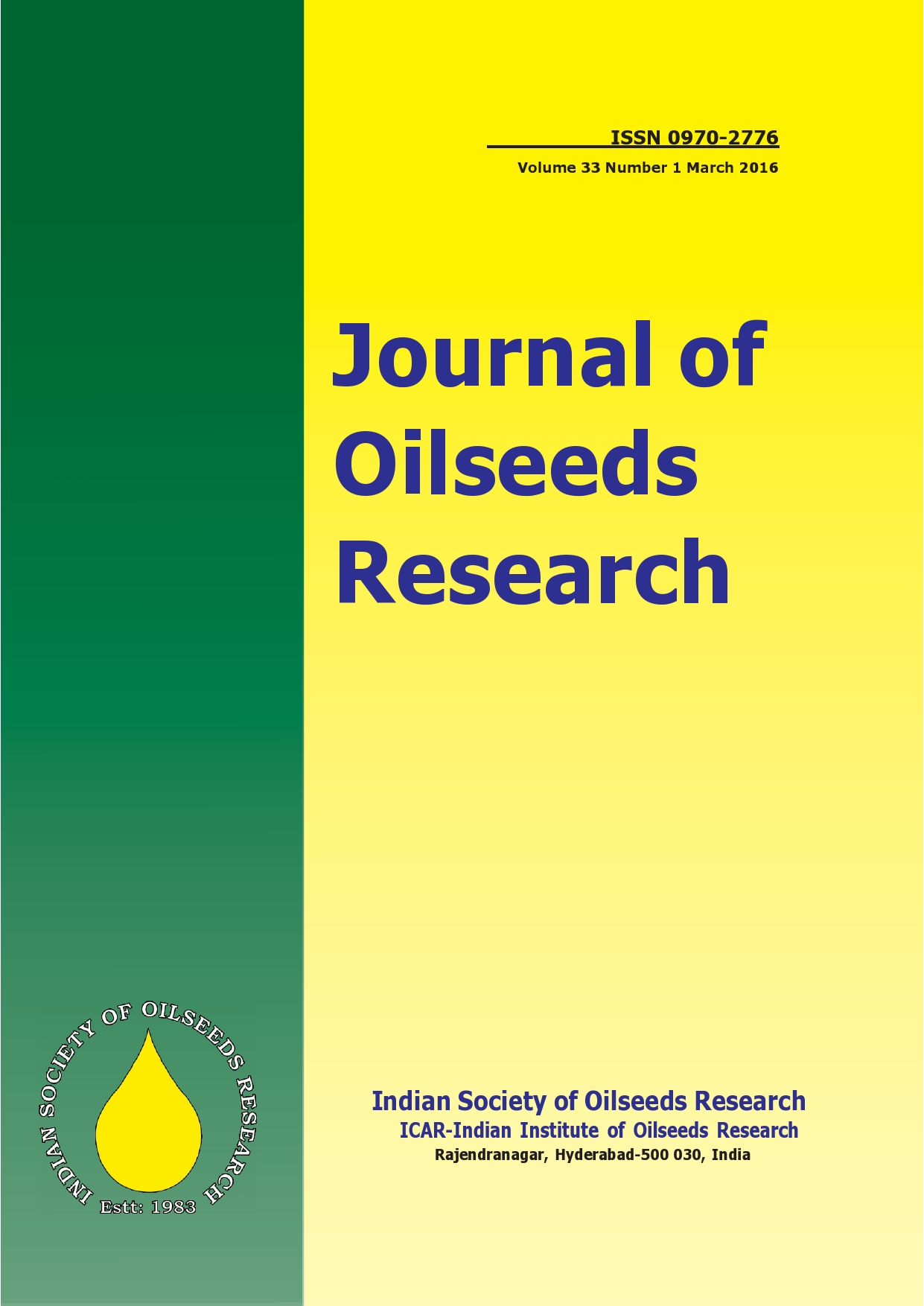Influence of biocontrol agents and fungicides on vegetative parameters of groundnut (Arachis hypogaea L.) under greenhouse conditions
INFLUENCE OF BIOCONTROL AGENTS & FUNGICIDES ON VEGETATIVE PARAMETERS OF GROUNDNUT
88 / 0
Keywords:
Compatibility, Fungicides, Groundnut, P. fluorescens, Rhizobium, T. virideAbstract
In the present study the compatibility of various plant growth promoting organisms [Pseudomonas fluorescens (Pf), Trichoderma viride (Tv) and Rhizobium (Rhi)] along with fungicides (mancozeb, tebuconazole and carbendazim + mancozeb) was tested on groundnut crop (cv. K-6) variety under greenhouse conditions. At 45 days after sowing (DAS), maximum (109) number of root nodules was observed in plants treated with combination of biocontrol agents Pf, Tv and Rhi. Maximum (1314.7 mm) root length was observed in Pf and Rhi combination while root area was recorded to be maximum (1341.8 mm2) in Rhi treatment. Root diameter (3.7 mm), root hairs (79.5) and chlorophyll content (51.7) were significant in Pf and Rhi combination. At 90 DAS, boosting effect on root nodules with maximum number (111) was seen in seeds treated with combination of biocontrol agents Pf, Tv and Rhi. Root length was prominent (1775.5 mm) in Tv treated plants whereas root area was maximum (1865.6 mm2) in Pf and Rhi combination. Maximum root diameter (4.8 mm) was found in Pf and Rhi combination whereas Pf, Tv and Rhi combination showed significant (108.5) root hair number. Pf treated plants showed remarkable (60.3) chlorophyll content compared to other treatments. The study showed increase in overall growth parameters in biocontrol agents treated plants followed by fungicides.
Downloads
References
Akgul D K, Ozgonen H and Ali Erkilic 2011. The effect of seed treatment with fungicides on stem rot caused by Sclerotium rolfsii in peanut. Pakisthan Journal of Botany, 43(6): 2991-2996.
Ameer B S, Sarma B K, Singh D P, Annapurna K and Singh U P 2006. Differential methods of inoculation with PGPR induce synthesis of phenylalanine ammonia lyase and phenolic compounds differentially in chickpea (Cicer arietinum). Folia Microbiology, 51(5): 463-468.
Chet I, Inbar J and Hadar I 1997. Fungal antagonists and mycoparasites. In: Wicklow D T and SoderströmB (Eds.), The Mycota IV: Environmental and Microbial Relationships, Springer-Verlag, Berlin, pp. 165-184.
Ezzahiri B and Khattabi 2004. Sclerotiumin the Doukkala, Marocco Region: Present Situation and Control Techniques. 67th IIRB Congress, Bruxelles, Belgium.
Ganesan S and Sekar R 2012. Fluorescent Pseudomonas as plant growth promoting Rhizobacteria and biocontrol agents in groundnut crop (Arachis hypogaea L.). International Journal of Applied Bio Research, 12: 1-6.
Harman G E, Howell C R, Viterbo A, Chet I and Lorito M. 2004. Trichoderma species - opportunistic, avirulent plant symbionts. Natural Review of Microbiology, 2: 43-56.
Manjula K, Krishna Kishore G, Girish A G and Singh S D 2004.Combined application of Pseudomonas fluorescens and Trichoderma viride has an improved biocontrol activity against stem rot in groundnut. Plant Pathology Journal, 20(1): 75-80.
Mc Lean, Hunt J and Stewart A 2001. Comparison of biocontrol agent Trichoderma harzianum C52 with selected fungicides. New Zealand Plant Protection, 54: 84-88.
Meena B and Marimuthu T 2012. Effect of application methods of Pseudomonas fluorescens for the late leaf spot of groundnut management. Journal of Biopesticide, 5(1): 14-17.
Nigam S N and Aruna R 2008. Stability of soil plant analytical development (SPAD) chlorophyll meter reading (SCMR) and specific leaf area (SLA) and their association across varying soil moisture stress conditions in groundnut (Arachish ypogaea L.). Euphytica, 160(1): 111-117.
Podile A R and Kishore G K 2002.Biological control of peanut diseases. In: Gnanamanickam S and Marcel Dekker (Eds.), Biological Control of Crop Diseases, New York, pp.131-160.
Poldma P, Jaaksor K, Merivve A and Albrecht A 2000. Trichoderma viride promotes growth of cucumber plant. In: Proceeding of the International Conference on Development of Environmental Friendly Protection in the Baltic Region.
Transactions of Estonia Agricultural University 209, Estonia supplement, pp. 28-29.
Ramesh R and Korikanthimath V S 2006. Management of groundnut root rot by Trichoderma viridae and Pseudomonas fluorescens under rainfed condition. Indian Journal of Plant Production, 34(2): 239-241.
Sajeli A B, Basha S A, Raghavendra G, Kumar M N, Singh Y, Patil J V, Tanemura Y and Fujimoto Y 2014. Isolation and biochemical characterization of antimicrobial cyclic dipeptides from Pseudomonas fluorescens and their efficacy on sorghum grain mold fungi. Chemistry and Biodiversity, 11: 92-100.
Sarma B K, Ameer Basha S, Singh D P and Singh U P 2007. An alternative approach to protecting chickpea (Cicer arietinum) from stem rot caused by Sclerotinia sclerotiorum. Crop Protection, 26: 1042-1048.
Songsri P S, Jogloy C, Holbrook T, Kesmala N, Vorasoot C, Akkasaeng A and Patanothai 2009. Association of root, specific leaf area and SPAD chlorophyll meter reading to water use efficiency of peanut under different available soil water. Agricultural Water Management, 96: 790-798.
